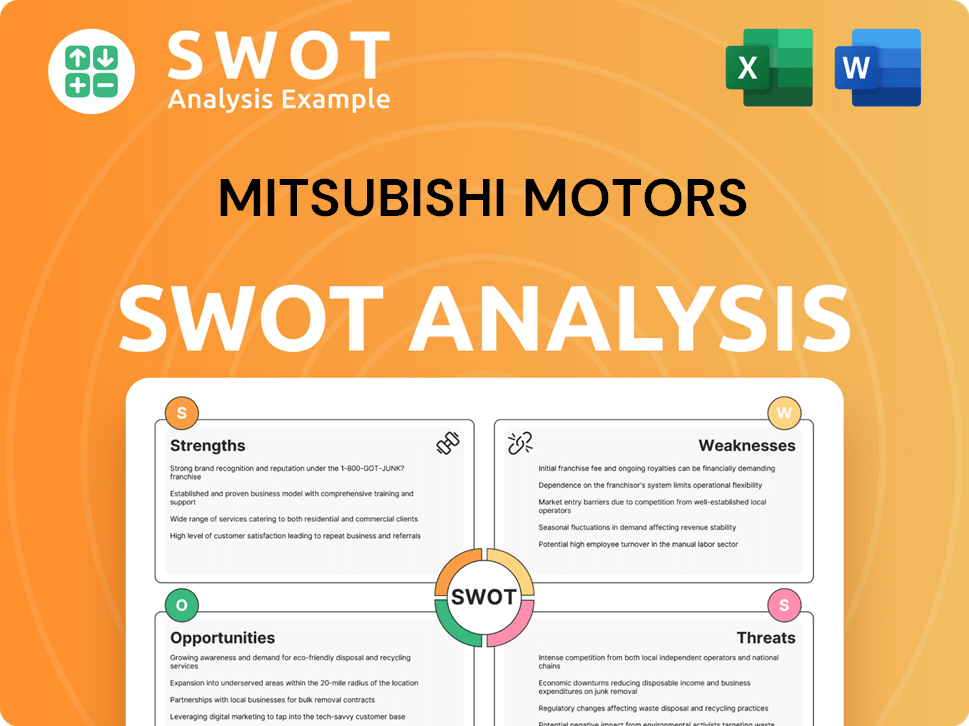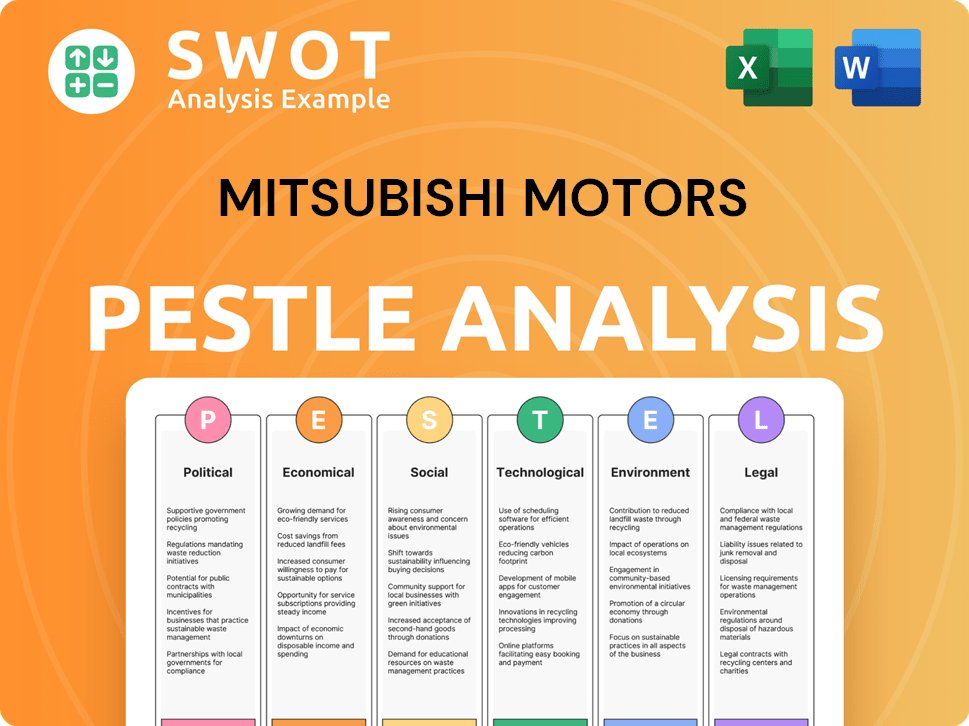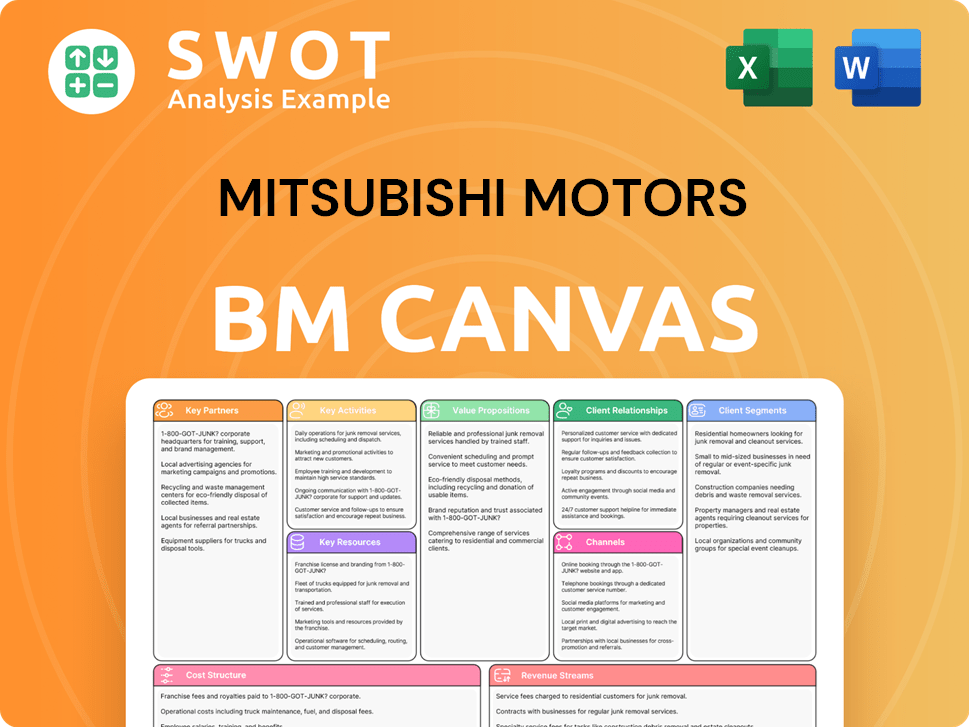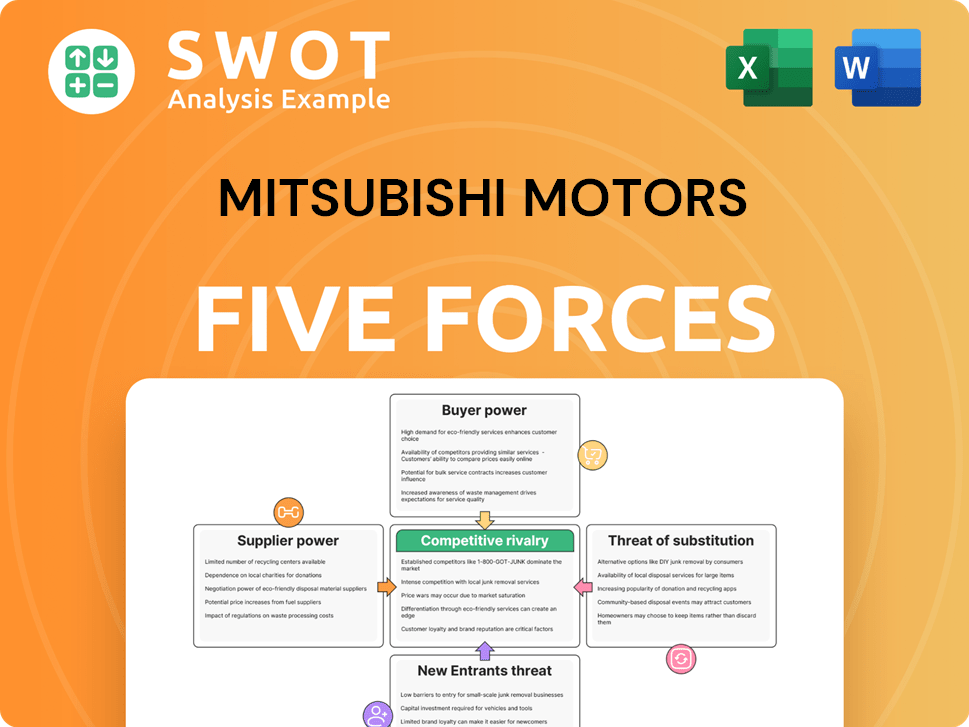Mitsubishi Motors Bundle
Can Mitsubishi Motors Thrive in Today's Cutthroat Car Market?
The automotive industry is in constant flux, with electrification and autonomous driving reshaping the landscape. Mitsubishi Motors, a long-standing player, is adapting to these changes. Founded in 1970, the company has a rich history and is now focused on strategic partnerships and key markets.

This analysis dives deep into the Mitsubishi Motors SWOT Analysis, exploring its position within the Mitsubishi Motors competitive landscape. We'll examine its Mitsubishi Motors competitors, evaluate its Mitsubishi Motors market analysis, and uncover the strategies shaping its future in the face of intense automotive industry competition. Understanding Mitsubishi's Mitsubishi Motors strategy is crucial for anyone tracking car market share dynamics.
Where Does Mitsubishi Motors’ Stand in the Current Market?
Mitsubishi Motors maintains a distinct market position within the global automotive industry. The company's focus is on specific vehicle segments and geographic regions rather than pursuing sheer volume across all categories. This strategic approach allows for a more targeted allocation of resources and a stronger presence in key markets.
The company's primary product lines include SUVs and commercial vehicles, forming the backbone of its sales. Mitsubishi has also made a significant push into electric and hybrid vehicles, with the Outlander PHEV being a notable offering. The company's strategic alliance with Nissan and Renault also plays a crucial role in its market positioning, allowing for shared platforms, technologies, and economies of scale.
Mitsubishi's 2024 financial performance shows its focus on profitability within its chosen segments. Mitsubishi Motors reported an operating profit of 190.2 billion yen for the fiscal year ending March 31, 2024, indicating stable financial health amidst industry challenges. This financial performance demonstrates a focused and profitable operation within its chosen segments. For a deeper dive into their strategies, consider exploring the Marketing Strategy of Mitsubishi Motors.
Mitsubishi Motors focuses on specific vehicle segments, particularly SUVs, pickup trucks, and electrified vehicles. This specialization allows for a more targeted approach to product development and marketing. In the ASEAN region, models like the Triton pickup truck and Xpander MPV have a strong presence.
Mitsubishi's market presence varies by region, with a strong foothold in the ASEAN region. In North America and Europe, its presence is more niche, concentrating on models like the Outlander and Eclipse Cross. This regional focus allows for tailored strategies.
The product portfolio is centered around SUVs and commercial vehicles, reflecting a strategic shift away from a broad range of passenger cars. The Outlander PHEV is a key model in the electric and hybrid vehicle segment. This concentrated portfolio aims to leverage strengths in durability and utility.
The alliance with Nissan and Renault is crucial, enabling shared platforms, technologies, and economies of scale. This collaboration supports cost efficiency and access to a broader range of technologies. These partnerships help Mitsubishi compete more effectively.
Mitsubishi Motors' competitive landscape is shaped by its focus on specific segments and regions. The company's strategy involves leveraging its strengths in SUVs, pickup trucks, and electrified vehicles. Key performance indicators include sales figures, customer satisfaction, and technological advancements.
- The ASEAN region remains a critical market for Mitsubishi, with strong sales of models like the Triton and Xpander.
- The Outlander PHEV has seen success in several markets, highlighting the company's push into electric and hybrid vehicles.
- Strategic alliances with Nissan and Renault provide crucial support for technology and cost efficiency.
- Mitsubishi Motors' financial health is demonstrated by its operating profit of 190.2 billion yen for the fiscal year ending March 31, 2024.
Mitsubishi Motors SWOT Analysis
- Complete SWOT Breakdown
- Fully Customizable
- Editable in Excel & Word
- Professional Formatting
- Investor-Ready Format

Who Are the Main Competitors Challenging Mitsubishi Motors?
The Mitsubishi Motors competitive landscape is shaped by intense rivalry across various vehicle segments and geographical regions. Understanding its key competitors is crucial for assessing its market position and strategic challenges. The automotive industry competition is fierce, with established players and emerging brands constantly vying for market share.
Mitsubishi Motors market analysis reveals a complex interplay of direct and indirect competitors. The company's success depends on its ability to differentiate its products, adapt to changing consumer preferences, and navigate the evolving automotive landscape. Analyzing Mitsubishi Motors' strategy is essential for understanding its approach to maintaining competitiveness.
Mitsubishi Motors competitors include both traditional automakers and newer entrants, each with unique strengths and strategies. This competitive environment influences Mitsubishi Motors' future market outlook and its ability to achieve its business objectives. The company's performance is also affected by car market share dynamics.
In the SUV segment, Mitsubishi faces competition from Japanese automakers like Toyota, Honda, and Nissan. These brands often have broader model ranges and stronger brand recognition. Korean manufacturers such as Hyundai and Kia also offer competitive products.
In the pickup truck segment, particularly in markets like Southeast Asia and Australia, Mitsubishi's Triton (L200) competes with Toyota Hilux, Ford Ranger, Isuzu D-Max, and Nissan Navara. These competitors focus on features like towing capacity and off-road capability.
The shift towards electric and hybrid vehicles introduces new competitors, including Tesla and Chinese EV manufacturers like BYD and Nio. These companies are increasingly entering global markets with advanced electric offerings. Mitsubishi Motors' electric vehicle competition is growing.
Indirect competition comes from companies offering alternative transportation solutions or influencing consumer spending habits. Mergers and alliances, like the Stellantis group, further intensify the competitive dynamics. This broader landscape affects Mitsubishi Motors' global market presence analysis.
Mitsubishi Motors vs Toyota market share is a key area of competition in many markets. Toyota often holds a significant advantage due to its extensive model range and brand recognition. Understanding these dynamics is crucial for assessing Mitsubishi's performance.
Analyzing Mitsubishi Motors competitive advantages and disadvantages helps in understanding its position in the market. Factors such as product offerings, pricing strategies, and brand perception play a crucial role. Understanding these aspects is crucial for Mitsubishi Motors' key performance indicators.
The competitive landscape also involves factors such as Mitsubishi Motors' pricing strategy compared to rivals, Mitsubishi Motors' product portfolio comparison, and Mitsubishi Motors' technological advancements competition. Who are Mitsubishi Motors' main competitors in the US and other key markets is a critical question. How does Mitsubishi Motors compare to Honda, Toyota, and other rivals in terms of sales, features, and customer satisfaction? Addressing these questions helps in a comprehensive Mitsubishi Motors market analysis. For a deeper dive, consider exploring Mitsubishi Motors challenges in the automotive industry and the company's strategies to overcome them. Further insights can be found in articles examining Mitsubishi Motors sales figures compared to competitors and Mitsubishi Motors customer satisfaction compared to rivals.
Several competitors pose significant challenges to Mitsubishi Motors. These rivals have established positions and are continuously innovating to gain market share. Understanding their strategies is key to Mitsubishi Motors' strategy.
- Toyota: A major competitor, Toyota's RAV4 and Highlander compete directly with Mitsubishi's SUV offerings. Toyota's strong brand reputation and extensive dealer network are significant advantages. In 2024, Toyota's global sales reached approximately 9.5 million units, highlighting its market dominance.
- Honda: Honda's CR-V and HR-V are key competitors in the SUV segment. Honda's focus on fuel efficiency and reliability appeals to a broad customer base. Honda's global sales in 2024 were around 4.1 million units.
- Nissan: Nissan's Rogue/X-Trail and Qashqai compete in the SUV market. Nissan's advanced technology features and competitive pricing are key strategies. Nissan sold approximately 3.4 million vehicles globally in 2024.
- Hyundai and Kia: These Korean automakers offer competitive pricing and modern designs. The Hyundai Tucson and Kia Sportage are popular choices. Hyundai and Kia collectively sold over 6.5 million vehicles worldwide in 2024.
- Ford: In the pickup truck segment, Ford's Ranger competes with Mitsubishi's Triton. Ford's strong presence in the North American market and robust truck offerings are key strengths. Ford's global sales in 2024 were about 4.8 million units.
Mitsubishi Motors PESTLE Analysis
- Covers All 6 PESTLE Categories
- No Research Needed – Save Hours of Work
- Built by Experts, Trusted by Consultants
- Instant Download, Ready to Use
- 100% Editable, Fully Customizable

What Gives Mitsubishi Motors a Competitive Edge Over Its Rivals?
The competitive landscape for Mitsubishi Motors is shaped by its strategic advantages and the dynamics of the automotive industry. Growth Strategy of Mitsubishi Motors focuses on leveraging its strengths in specific market segments and regions. This approach helps it compete effectively against larger rivals.
Mitsubishi Motors faces competition from various automakers, each with its own strengths and weaknesses. Understanding these competitive dynamics is crucial for evaluating the company's market position and future prospects. This analysis considers key aspects such as brand reputation, technological innovation, and strategic partnerships.
The company's ability to adapt to changing market conditions and consumer preferences will be critical for its long-term success. The automotive industry is constantly evolving, with new technologies and business models emerging. Mitsubishi Motors must navigate these changes to maintain its competitive edge.
Mitsubishi Motors benefits from a strong brand reputation, particularly for durability and reliability. This is especially true in the SUV and pickup truck segments. This reputation is built over decades, resonating with consumers seeking dependable vehicles.
The Super All-Wheel Control (S-AWC) system enhances handling and stability. This proprietary technology contributes to off-road capabilities and safety features. Mitsubishi's early investment in plug-in hybrid electric vehicle (PHEV) technology, like the Outlander PHEV, gives it a competitive advantage in the electrified vehicle market.
The alliance with Nissan and Renault provides access to shared resources and economies of scale. This collaboration helps reduce costs and accelerate product development. These partnerships are crucial for navigating the complexities of the automotive industry.
Mitsubishi's strong presence in the ASEAN market is a significant advantage. Tailored product offerings and effective distribution networks in these key growth areas are crucial. The focus on specific regional markets allows for more effective strategies.
Mitsubishi Motors leverages its brand reputation, technological innovations, strategic alliances, and regional focus to compete in the automotive industry. These advantages help the company differentiate itself from rivals, especially in the SUV and PHEV markets. The company's focus on specific product strengths and strategic partnerships aims for sustainable growth.
- Brand Reputation: Strong reputation for durability and reliability.
- Technological Innovation: S-AWC system and PHEV technology.
- Strategic Alliances: Partnerships with Nissan and Renault.
- Regional Focus: Strong presence in the ASEAN market.
Mitsubishi Motors Business Model Canvas
- Complete 9-Block Business Model Canvas
- Effortlessly Communicate Your Business Strategy
- Investor-Ready BMC Format
- 100% Editable and Customizable
- Clear and Structured Layout

What Industry Trends Are Reshaping Mitsubishi Motors’s Competitive Landscape?
The Owners & Shareholders of Mitsubishi Motors face a dynamic automotive industry landscape, shaped by rapid technological advancements and shifting consumer preferences. The company's competitive position is influenced by its product portfolio, market presence, and strategic alliances. Understanding the industry trends, future challenges, and opportunities is crucial for navigating this environment and ensuring sustainable growth. A thorough Mitsubishi Motors market analysis is essential for making informed decisions.
The automotive industry is undergoing a significant transformation driven by electrification, autonomous driving, and connectivity. These trends present both challenges and opportunities for Mitsubishi Motors. The company must adapt to these changes to remain competitive. The success of its strategy will affect its future market outlook and its ability to maintain and grow its market share.
The automotive industry is experiencing a major shift towards electric vehicles (EVs), driven by environmental regulations and consumer demand. Autonomous driving and connectivity features are also becoming increasingly important. These trends require significant investments in technology and infrastructure. The automotive industry competition is intensifying due to these changes.
Mitsubishi faces challenges such as volatile raw material prices, particularly for batteries, and supply chain disruptions. The growing competition from Chinese automakers is also a concern. Adapting to changing consumer preferences and technological advancements is crucial for survival. These factors will impact Mitsubishi Motors' key performance indicators.
Emerging markets, especially in Southeast Asia, offer strong growth potential for Mitsubishi's SUVs and pickup trucks. Expanding its electric and hybrid vehicle lineup and exploring new mobility services can also drive growth. Strategic partnerships, such as the alliance with Nissan and Renault, are vital. These opportunities can improve Mitsubishi Motors' sales figures compared to competitors.
Mitsubishi needs to focus on its strengths in the SUV and pickup segments while expanding its electrified offerings. Strategic partnerships are essential for sharing R&D costs and accelerating innovation. Adapting to changing consumer preferences and technological advancements is crucial. A strong Mitsubishi Motors strategy is vital for success.
The Mitsubishi Motors competitive landscape is characterized by intense competition from established automakers and new entrants. The company's success depends on its ability to innovate, adapt, and capitalize on emerging market opportunities. Understanding Mitsubishi Motors' competitors and their strategies is vital for making informed decisions. The Car market share is a key indicator of success.
- The shift to EVs requires significant investments in battery technology and charging infrastructure.
- Supply chain disruptions and volatile raw material prices pose major challenges.
- Competition from Chinese automakers is increasing, particularly in the EV market.
- Emerging markets offer growth opportunities, especially in Southeast Asia.
Mitsubishi Motors Porter's Five Forces Analysis
- Covers All 5 Competitive Forces in Detail
- Structured for Consultants, Students, and Founders
- 100% Editable in Microsoft Word & Excel
- Instant Digital Download – Use Immediately
- Compatible with Mac & PC – Fully Unlocked

Related Blogs
- What are Mission Vision & Core Values of Mitsubishi Motors Company?
- What is Growth Strategy and Future Prospects of Mitsubishi Motors Company?
- How Does Mitsubishi Motors Company Work?
- What is Sales and Marketing Strategy of Mitsubishi Motors Company?
- What is Brief History of Mitsubishi Motors Company?
- Who Owns Mitsubishi Motors Company?
- What is Customer Demographics and Target Market of Mitsubishi Motors Company?
Disclaimer
All information, articles, and product details provided on this website are for general informational and educational purposes only. We do not claim any ownership over, nor do we intend to infringe upon, any trademarks, copyrights, logos, brand names, or other intellectual property mentioned or depicted on this site. Such intellectual property remains the property of its respective owners, and any references here are made solely for identification or informational purposes, without implying any affiliation, endorsement, or partnership.
We make no representations or warranties, express or implied, regarding the accuracy, completeness, or suitability of any content or products presented. Nothing on this website should be construed as legal, tax, investment, financial, medical, or other professional advice. In addition, no part of this site—including articles or product references—constitutes a solicitation, recommendation, endorsement, advertisement, or offer to buy or sell any securities, franchises, or other financial instruments, particularly in jurisdictions where such activity would be unlawful.
All content is of a general nature and may not address the specific circumstances of any individual or entity. It is not a substitute for professional advice or services. Any actions you take based on the information provided here are strictly at your own risk. You accept full responsibility for any decisions or outcomes arising from your use of this website and agree to release us from any liability in connection with your use of, or reliance upon, the content or products found herein.